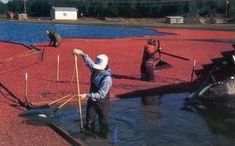
The forecast for the 2003 cranberry crop in the US is 5.83 million barrels, up three per cent from 2002 and nine per cent above 2001.
The figures, released by the US department of agriculture show that Wisconsin is the only state forecasting a decrease in production from a year ago.
Production in Wisconsin is forecast at 3.05 million barrels, five per cent
below 2002 but seven per cent above 2001. Cranberry farmers in Wisconsin report having an average growing season with good berry set.
Rainfall in the Badger State has been mostly adequate, with some areas a little dry and in need of additional rain before harvest. Some winter damage has also been reported in northern and central areas of the state. Crop maturity is also reported by the authorities to be about a week behind normal.
Meanwhile, the Massachusetts crop is forecast at 1.70 million barrels, up 17 per cent on 2002 and 20 per cent above 2001. Many Massachusetts growers took advantage of the long, cold winter to sand their bogs, and the wet, cool spring has allowed bogs to recover from last year's drought. However, according to the USDA, crop maturity in the state has also been slightly delayed.
New Jersey is expecting a crop of 470,000 barrels, up nine per cent on 2002 but 17 per cent below 2001. Growers have also reported that bloom, fruit set, and fruit size are in line with recent averages and there has been no significant weather damage in the state.
Across the country in Oregon, the crop is forecast at 440,000 barrels, two per cent above last year's crop and up 21 per cent from 2001. Weather conditions have been favourable for cranberry production in the state: a cold, wet spring prolonged bloom but gave way to warm summer temperatures which have helped fruit set and sizing in the state.
The crop in neighbouring Washington is forecast at 170,000 barrels, five per cent above last year and 20 per cent above 2001. Conditions for production in the Evergreen State have been very good: a mild winter followed by a wet spring and warm summer have combined to provide excellent conditions. Many old vines have slowly been replaced with higher yielding types as producers are switching to intensive management of their bogs.
Some growers have increased acreage since the restrictive marketing order was lifted in 2001. Under that order, growers could only sell 65 per cent of their historic average sales to the processors.
These restrictions applied to all five major cranberry producing states, but the lack of marketing restrictions in 2002 and 2003 led some growers to increase acreage.
This increased acreage combined with good growing conditions in most states have resulted in the higher cranberry production forecast.






No comments yet